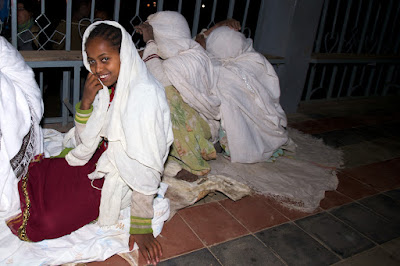As we hit the road soutward toward the capital a large funeral procession of several hundred people in white robes cut across the highway. Most of the people are barefoot, and they all walk briskly in the cool morning sun, and their candid attire contrasts starkly with the black asphalt.
Many other people, as usual, walk along the side of the brand new highway. An "East African Bamboo Project" stand proudly displays, well, bamboo poles for sale, and a wide choice of mosquito brushes.
At 10:30 we stop at a gas station for some coffee. Good, strong, dense Italian coffee made with real Italian espresso machines. Coffee is a good connection between our two countries, they have the coffee and we brought in the machines, though the traditional coffee ceremony, as we have experienced it several times during this trip, is not to be missed.
 |
| Sharing injera and raw meat with our driver at a road side eatery |
Lunch is at a roadside eatery/butcher shop/bar/gas station. The butcher, in a blood-stained white coat, is busy cutting up some beef into thin strips of meat. He and one of is assistants use special knives with a rounded blade that looks like a huge fishing hook. As usual, I eat with the driver and get a nice ingera with raw beef, all accompanied by a cool bottle of never to be missed Coca Cola.
A few kilometers down the road we cross the Nile again, this time on foot. We walk over a bridge built by the Italians, next to which in 2008 the Japanese built another one, more modern looking but definitely less charming, which is used by our bus. There is no traffic at all today on either bridge. A lone baboon plays on top of the ridge as we drive away.
 |
| Italian and Japanese bridges on the Nile |
Shortly afterwards we meet some farmers having a tea break while they are gathering hay, and the are very kind to invite us over for a drink. About a dozen men labor away while a lady walks around with a full pot handing over cupfuls of tea.
One last stop before reaching the capital is at
Debre Libanos, an ancient monastery where a wedding is taking place in one of the
churches. Lots of friends and relatives in white and red dresses, rythmic music and a conservative, almost stiff posture on the part of the newlyweds.
This is not a happy site in the memory of Italy's presence in Ethiopia. Here Graziani exterminated over 200 monks when he suspected they had connived with those who had attempted on his life.






















